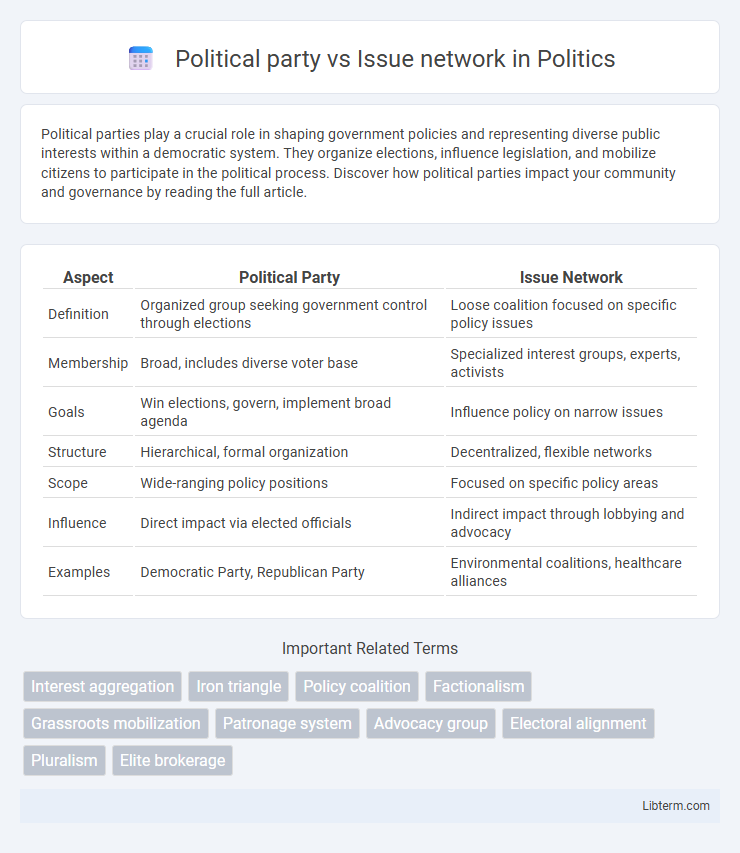Political parties play a crucial role in shaping government policies and representing diverse public interests within a democratic system. They organize elections, influence legislation, and mobilize citizens to participate in the political process. Discover how political parties impact your community and governance by reading the full article.
Table of Comparison
| Aspect | Political Party | Issue Network |
|---|---|---|
| Definition | Organized group seeking government control through elections | Loose coalition focused on specific policy issues |
| Membership | Broad, includes diverse voter base | Specialized interest groups, experts, activists |
| Goals | Win elections, govern, implement broad agenda | Influence policy on narrow issues |
| Structure | Hierarchical, formal organization | Decentralized, flexible networks |
| Scope | Wide-ranging policy positions | Focused on specific policy areas |
| Influence | Direct impact via elected officials | Indirect impact through lobbying and advocacy |
| Examples | Democratic Party, Republican Party | Environmental coalitions, healthcare alliances |
Introduction to Political Parties and Issue Networks
Political parties are organized groups seeking to influence government policy by electing candidates to public office, focusing on broad agendas and voter mobilization. Issue networks consist of loosely connected groups of interest organizations, government agencies, and policy specialists collaborating on specific policy areas or issues. While political parties aim at gaining control of government, issue networks emphasize policy expertise and advocacy within particular sectors.
Defining Political Parties
Political parties are organized groups aiming to influence government policy by nominating candidates and securing electoral victories, serving as a central mechanism for political participation and governance. They provide structured platforms that aggregate diverse public interests into coherent policy agendas, contrasting with issue networks, which are informal coalitions focused on specific policy concerns. Defining political parties involves recognizing their role in stabilizing political systems through structured competition and collective decision-making.
Understanding Issue Networks
Issue networks consist of dynamic alliances among interest groups, policymakers, and experts centered on specific policy concerns, offering flexibility and specialized knowledge that political parties cannot easily provide. Unlike political parties that seek broad electoral support and govern through organized platforms, issue networks influence legislation and policy through targeted advocacy and expertise on singular or interconnected issues. Understanding issue networks enhances insight into the policymaking process by revealing how diverse stakeholders shape decisions beyond traditional party politics.
Historical Development of Political Parties
The historical development of political parties traces back to the early formations of organized groups competing for power in the late 18th century, starting with the Federalists and Democratic-Republicans in the United States. Unlike issue networks, which are fluid coalitions of interest groups, political parties established structured platforms to aggregate diverse interests under cohesive policy agendas and electoral strategies. The evolution of parties has solidified their role in shaping governance, voter mobilization, and legislative organization over time.
Evolution and Rise of Issue Networks
Issue networks have evolved as fluid coalitions of interest groups, policy experts, and government officials influencing specific policy areas, contrasting with the more structured and hierarchical nature of political parties. The rise of digital communication and increasing policy complexity have facilitated the growth of these networks, enabling diverse stakeholders to collaborate and shape legislation outside traditional party lines. This shift reflects a move towards specialized, decentralized policymaking processes where issue networks often exert significant influence over public policy.
Structure and Organization: Parties vs. Issue Networks
Political parties have a hierarchical structure with formal leadership, clear membership, and organized committees that work to win elections and govern. Issue networks consist of loose, fluid alliances among various stakeholders including interest groups, policymakers, and experts who collaborate on specific policy issues without formal membership or leadership. Unlike political parties, issue networks emphasize flexible cooperation and information exchange rather than centralized decision-making.
Roles in Policy-Making and Governance
Political parties structure policy-making by organizing voter preferences into coherent platforms and controlling legislative agendas, enabling coordinated governance and policy implementation. Issue networks consist of diverse stakeholders, including interest groups, experts, and bureaucrats, who collaborate to influence specific policy areas through advocacy, negotiation, and information exchange. While political parties drive broad governance strategies, issue networks specialize in shaping detailed policy outcomes within particular sectors.
Influence on Public Opinion and Elections
Political parties shape public opinion and elections by organizing voter bases, crafting policy platforms, and mobilizing support through campaigns and media outreach. Issue networks influence public opinion by bringing together diverse stakeholders such as interest groups, experts, and media to spotlight specific policy concerns, thereby pressuring policymakers and swaying voter preferences on targeted issues. While political parties seek broad electoral mandates, issue networks drive focused advocacy that can shift public attitudes and election outcomes on specialized topics.
Advantages and Limitations of Each System
Political parties offer structured platforms that unify voters and streamline policy-making, enabling coherent governance and electoral accountability, but they often face limitations such as ideological rigidity and potential suppression of minority views. Issue networks provide flexible and inclusive coalitions that promote specialized expertise and grassroots participation, fostering diverse viewpoints and policy innovation, yet they can lead to fragmented influence and challenges in achieving consensus. Both systems balance representation and efficiency differently, reflecting varying strengths in democratic engagement and policy development.
Future Trends: Collaboration or Competition?
Political parties and issue networks will increasingly shape governance through either collaboration or competition depending on policy areas and stakeholder interests. Emerging digital platforms enable both entities to mobilize support rapidly, creating dynamic interactions that influence legislative agendas and public opinion. Future trends suggest a hybrid approach where strategic alliances form on specific issues while competition persists over broader ideological control.
Political party Infographic

 libterm.com
libterm.com